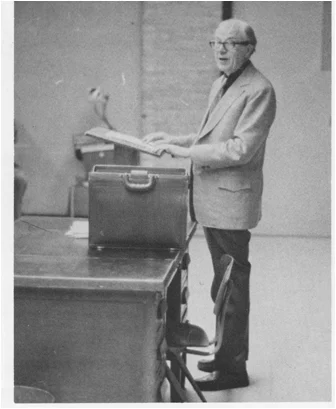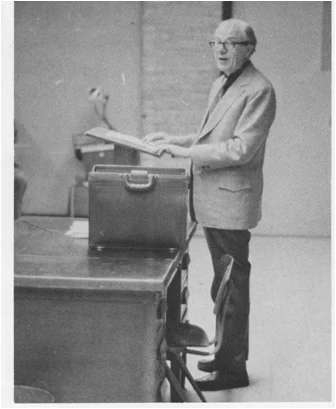Watts (1898–1993) served as Northwood’s director of economic education and chairman of the Division of Social Studies from 1963 to 1984.
(Excerpted from his essay, “From Sovereign Governments to Sovereign Individuals,” first published in 1967 and included in several editions of the book When We Are Free.)
The first immigrants from Europe in the 16th and early 17th centuries did not come to the Americas for freedom so much as to establish their own kinds of regimented, or “planned,” societies. The conquistadors of Spain, like the legions of ancient Rome, came to govern, enslave, and plunder the natives. They invaded the more densely populated regions and established military dictatorships for the purpose of forcing the natives to produce for the Emperor and his agents.
For a time, this imperialism appeared successful, yielding greater returns than the costs of the expeditions necessary to collect the tribute. Consequently, the government and its officials gained social prestige throughout the Empire at the expense of producers—farmers, craftsmen, and businessmen. Government, the army, and the Church attracted the ambitious and talented; and the officialdom which exploited the producers in the overseas colonies likewise taxed and regulated for its own purposes the producers of Spain. As a result agriculture, industry, and commerce languished or declined at home and abroad, and the Spanish Empire eventually collapsed for much the same reasons as did the empire of ancient Rome.
The motives and policies of the British settlers in North America were essentially different, except for the first few who began the Jamestown settlement in 1607. After the first year in Jamestown, when no sign of gold or precious stones was discovered, the immigrants from Great Britain came to produce, not to plunder.
Two of the first British settlements, however, Jamestown and Plymouth, began as collectives. In both, the officials organized the settlers on semi-military lines, assigned the tasks, and required each worker to bring his produce to the common “magazine,” or warehouse. The officials doled out these products according to the supposed needs of each settler. That is, they distributed the available goods according to the communist principle: “From each according to his ability, to each according to his need.” Any surplus was to go to England to pay interest and principal on the investments of the companies which financed the settlements on lands obtained by grant from the King. Since the companies which owned the land were also the King’s political agents, responsible for the government of the settlers, these first colonies were essentially socialistic in form and operation.
During this brief, early period of collectivism, neither colony became self-supporting. On the contrary, both seemed destined to fail. Even with further advances from the proprietors in England, and with what they begged from passing ships and from the Indians, the settlers starved, sickened, and died in the very land that later observers considered so rich in natural resources.
According to the theories of collectivists, the Plymouth experiment should have outlasted the one at Jamestown. The Plymouth Pilgrims came to establish a religious refuge, so that working for the common good was their religious duty. The Plymouth colonists, too, were in greater need; and according to collectivist theory, this is an added reason for rationing, or sharing, the necessaries of life.
Yet in the third year of the Plymouth colony, because the situation seemed so desperate, Governor Bradford abolished compulsory sharing and assigned parcels of land to individuals and families which they were to till as they chose, keeping the produce for themselves. He no longer required farmers, hunters, and fishermen to hand over their products to a common store.
Suddenly these Pilgrims, who had been too weak and ill to work for the common good, now found strength to hunt, fish, dig, and build for themselves and their dependents. So the famine ended, and soon the colonists were trading their surplus corn with the Indians for furs which they exported to England. In 1627, just three years after they instituted private enterprise, they were able to pay $1,800 to buy for themselves the investors’ rights and claims in the colony.
The Jamestown “managed economy” lasted longer because the London backers continued their financial aid longer. For nine years the proprietors’ Council tried to operate the settlement much like a state farm in present-day Russia. It invested heavily in sending experienced officials, food, clothing, tools, cattle, seed, and shiploads of able-bodied helpers to aid the settlers. Yet the colonists remained unable to support themselves even in the matter of food, let alone make a return to the Company; and the Governor complained of fraud, broken nets, lost boats, sickness, desertion, murder, insubordination, and treason.
At last, in 1616, the Council lost patience with the colonists. It refused to continue feeding men on land which they could till for themselves. Therefore, it gave each settler three acres and told him to provide for himself. He must continue to spend part of his time in the labor gangs producing for the common treasury, but he had to provide his own food and shelter.
That took care of the food problem so well that the Council soon decided to put all of the colony’s farming on the same individualistic basis. It gave 50 acres to each settler in return for a small rental, and resigned itself to what profit it might glean from carrying on whatever commerce the settlers might develop.
At once the Jamestown colony began to prosper, so that before long visitors from Europe were commenting on the lavish abundance of food in the new land where the settlers at first seemed sure they must starve. Everywhere else on earth, and among the American Indians who lived in primitive collectivism, recurrent famines continued and multitudes starved to death. But there was never another famine in British America. Instead, the farmers, hunters, and fishermen at these colonies became noted for their industry, for their well-stocked larders, for their sturdy physiques, and for their generosity to strangers and the needy.






